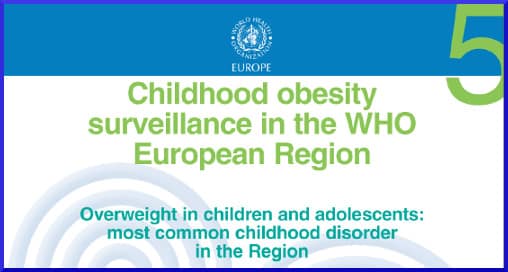 Some European countries have reduced their mortality rates when it comes to diabetes, cancer, and cardiovascular diseases (including strokes and heart attacks.) This is a good-news highlight from the World Health Organization’s recent release, “The European Health Report 2015.” Unfortunately, the 150-page document also contains a considerable amount of bad news, which can be read in its entirety by downloading the PDF file.
Some European countries have reduced their mortality rates when it comes to diabetes, cancer, and cardiovascular diseases (including strokes and heart attacks.) This is a good-news highlight from the World Health Organization’s recent release, “The European Health Report 2015.” Unfortunately, the 150-page document also contains a considerable amount of bad news, which can be read in its entirety by downloading the PDF file.
The Commission on Ending Childhood Obesity exists to provide the leaders of countries with guidance on policy options in order to treat existing childhood obesity and prevent more of it from developing. The goals include reducing the risk of morbidity and mortality and alleviating the psychosocial effects of obesity in both children and adults.
In June, the Commission on Ending Childhood Obesity met in Hong Kong. Dr. Margaret Chan, director general of WHO, told the gathering that by 2025, there will be as many as 70 million overweight and obese infants and young children in the world.
Tracking and Treating Obesity in Europe
In order to monitor such factors as indicators on mortality and risk, health inequities, and general well-being, WHO hopes to build a single health information system for all of Europe. Currently, each of the 53 member states of the European Region has different resources and different ways of doing things. WHO promotes broad international cooperation in the sharing of knowledge and experiences.
A difficulty that must be surmounted by any large-scale effort is the division of human suffering into two main causes — communicable diseases and non-communicable diseases. Obesity comes under the heading of non-communicable disease, but it contributes to premature mortality just the same. The European region has the world’s most elevated levels of tobacco and alcohol use. Equally as upsetting, the countries that make up the region have overweight and obesity rates that range from 45% to 67%.
One of the report’s sub-headings baldly states: “Prevalence of overweight and obesity alarmingly high and on the rise.” One chart, for example, shows the prevalence of overweight and obesity among 11-year-olds. For this demographic, the countries in the worst shape are Greece, Ireland, Portugal, Poland and Italy. The report says:
A recent survey conducted by the WHO Regional Office for Europe showed that more than 90% of countries reported having policies specifying requirements for a minimum level of physical education hours in schools and for the equipment needed for kindergartens and schools with exercise facilities. Only 20% of countries responding, however, reported having policies requiring bicycle lanes leading to schools and just 35% reported having measures to facilitate walking to schools.
The website NurseryWorld, which takes a particular interest in children from birth to age 5, discovered from the WHO statistics that the countries with the lowest obesity rates in that age group are Kazahkstan (1%) and the Czech Republic (6%). Why? Rebecca Jones of Emory University’s School of Public Health hypothesizes:
We think it is likely that, in countries with lower obesity rates, breastfeeding practices are playing a part as well as incorporation of nutrition education towards mothers and physical activity at young ages.
But so far, that is only a hunch. WHO is working hard to promote better information-gathering and record-keeping in all 53 of the European Region countries, so that such promising leads can be more efficiently followed up on, leading to the widespread implementation of successful policies. The picture on this page is from an official WHO publication urging the utmost cooperation from all concerned parties.
Your responses and feedback are welcome!
Source: “The European Health Report 2015,” euro.who.int, 2015
Source: “Interim Report of the Commission on Ending Childhood Obesity,” WHO/int, 2015
Source: “If current trends hold, childhood obesity will hit 70 million by 2025, warns UN health agency,” UN.org, 06/22/15
Source: “Research highlights severity of childhood obesity in Europe,” NurseryWorld.co.uk, 05/08/15
Image by WHO

 FAQs and Media Requests:
FAQs and Media Requests: 











